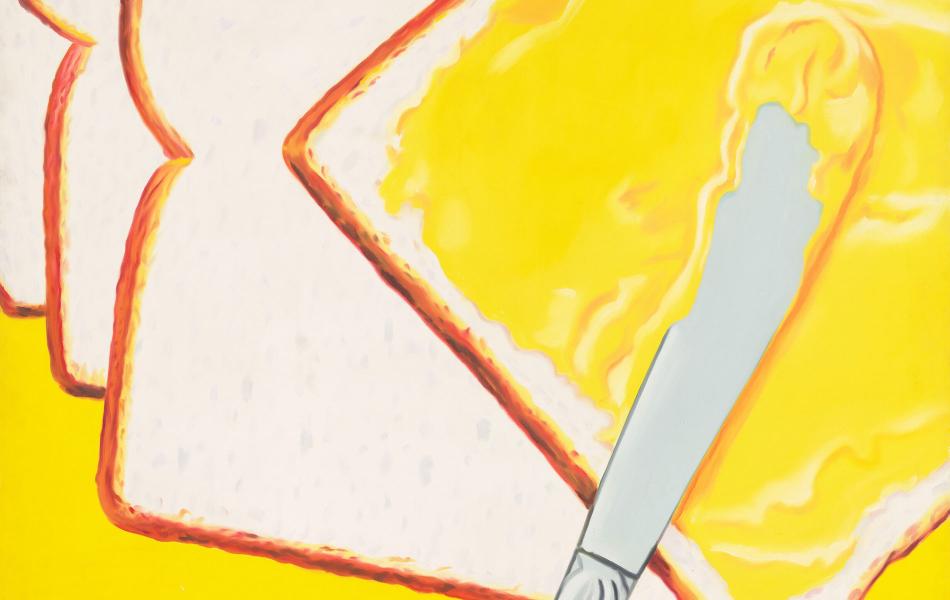Dishes with Oysters, Fruit, and Wine
c. 1620/1624
Osias Beert the Elder
Painter, Flemish, c. 1580 - 1624

Around the turn of the 17th century, a number of Flemish painters presented sumptuous tabletop still lifes to delight the viewer, and none surpassed Osias Beert. The carefully crafted objects and expensive delicacies that he depicted celebrate a world of abundance and beauty in a style that shows off Beert's mastery of textural effects and realistic detail.
The 11 oysters arranged upon the pewter plate are striking examples of this realism: their amorphous forms appear to be so liquid that one can readily imagine the oysters slipping from their pearly white shells. Nearby, two exotic shells emphasize the exceptional rarity of the objects and foods arrayed on the table. Luxurious sweets decorated with gold leaf fill the Wan-Li bowl in the foreground, while raisins, figs, and almonds overflow two other Ming-period bowls. Elegant sweets, including candied cinnamon bark and candied almonds that have been colored yellow, pink, and green, fill a ceramic tazza. Quince paste, which was stored in simple, wooden boxes, was another delicacy enjoyed at special festivities. The elegant Venetian-style glasses made by Flemish craftsmen hold red and white wine, so appropriate to this feast.
Beert minimized overlapping these exquisite objects by composing his scene with a high vantage point, thus preserving the individual character of his compositional elements. He had a great sensibility to color, using warm tones for the succulent morsels and wine that he situated behind the cool blues and grays of the oysters and candies. His range of whites varies from the subdued, chalky tones of the exotic sweets to the glistening sheen of the oysters. Beert's artistry is also evident in his sensitive rendering of the oysters' reflections in the pewter plate and in the delicate modeling of the "façon de Venise" wine carafe, whose form reflects the light from his studio window.
Beert's mastery of illusionism and carefully arranged compositions were the hallmarks of his style. He frequently revisited this format, subtly modifying the types of foods and their arrangement across the table. Such lavish still lifes are joyous, grand and proud visual statements of the material wealth and comforts of life among the elite of Flanders.

West Building Main Floor, Gallery 50-B
Artwork overview
-
Medium
oil on panel
-
Credit Line
-
Dimensions
overall: 52.9 x 73.4 cm (20 13/16 x 28 7/8 in.)
framed: 72.1 x 92.7 x 4.4 cm (28 3/8 x 36 1/2 x 1 3/4 in.) -
Accession Number
1995.32.1
More About this Artwork

Video: How to Style a Still Life: Osias Beert the Elder's "Dishes with Oysters, Fruit, and Wine"
Try your hand at creating your very own lavish scene inspired by Osias Beert the Elder’s Dishes with Oysters, Fruit, and Wine.

Article: Food Art Favorites to Feast Your Eyes On
Feast your eyes on our top 10 favorite food paintings at the National Gallery and download your favorites for free. See still lifes and pop art by Paul Cézanne, James Rosenquist, Robert Seldon Duncanson, and more.
Artwork history & notes
Provenance
(Kunsthandel P. de Boer, Amsterdam); purchased 1952 by private collector, Sweden; by inheritance to his son, Sweden;[1] (sale, Sotheby's, London, 6 July 1994, no. 17); (Johnny Van Haeften, London); purchased 24 May 1995 by NGA.
[1] Provenance according to 1994 Sotheby's sales catalogue.
Associated Names
Exhibition History
1995
Dutch Cabinet Galleries, National Gallery of Art, Washington, D.C., 1995-1996, no cat.
1998
A Collector's Cabinet, National Gallery of Art, Washington, D.C., 1998, no. 5.
1999
Still-Life Paintings from the Netherlands 1550-1720, Rijksmuseum, Amsterdam; The Cleveland Museum of Art, 1999-2000, no. 8, repro.
2000
Art for the Nation: Collecting for a New Century, National Gallery of Art, Washington, D.C., 2000-2001, unnumbered catalogue, repro.
2004
Pieter Claesz: Master of Haarlem Still Life, Frans Hals Museum, Haarlem; Kunsthaus Zürich; National Gallery of Art, Washington, D.C., 2004-2005, not in cat. (shown only in Washington).
2017
Slow Food: Dutch and Flemish Meal Still Lifes, 1600-1640, Royal Picture Gallery Mauritshuis, The Hague, 2017, no. 1.
Bibliography
1994
Bergström, Ingvar. "Osias Beert the Elder." In Dutch and Flemish Old Master Paintings. Johnny van Haeften, ed. London, 1994: no. 3 (unpaginated).
1996
Jeromack, Paul. "Acquisitions: Washington Gathers Flowers." Art Newspaper 7 (October 1996): 9.
Yapou, Yonna. "Dutch Acquisitions in Washington." Apollo 144, no. 418 (December 1996): 20.
1999
Hochstrasser, Julie Berger. "Feasting the Eye: Painting and Reality in the Seventeenth-century 'Bancketje.'" In Alan Chong and Wouter Th. Kloek. Still-Life Paintings from the Netherlands 1550-1720. Exh. cat. Rijksmuseum, Amsterdam; Cleveland Museum of Art, 1999: 73-85.
2004
Hand, John Oliver. National Gallery of Art: Master Paintings from the Collection. Washington and New York, 2004: 226-227, no. 180, color repro.
2005
Wheelock, Arthur K., Jr. Flemish Paintings of the Seventeenth Century. The Collections of the National Gallery of Art Systematic Catalogue. Washington, D.C., 2005: 2-4, color repro.
2020
Libby, Alexandra. “From Personal Treasures to Public Gifts: The Flemish Painting Collection at the National Gallery of Art.” In America and the Art of Flanders: Collecting Paintings by Rubens, Van Dyck, and their Circles, edited by Esmée Quodbach. The Frick Collection Studies in the History of Art Collecting in America 5. University Park, 2020: 142.
Wikidata ID
Q20176984

